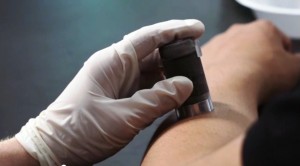A team of Rice University freshmen, part of the engineering design team known as Comfortably Numb, have developed a revolutionary device that eases the pain of an injection by numbing the skin prior to a shot.

According to the press release by Rice University, the 3D printed device actually produces a rapid chemical reaction to cool and numb the patient’s skin for about 60 seconds. This is truly a one of a kind invention as it can be integrated into the caps of sterile disposable needles. Aside from medicine, the new device could be used for ear piercings, swelling reduction and tattooing.
“Our (lab) device is 3D printed and consists of two sealed chambers containing the chemical ammonium nitrate and water. A simple twisting motion moves the chambers into alignment to allow the chemicals to flow through the chamber to produce a rapid endothermic reaction. We then numb the skin by contacting the device’s metal surface to the patient’s skin,” said mechanical engineering major Mike Hua, one of the members of the team which is also comprised of computer science major Greg Allison and bioengineering major Andy Zhang.
“We are targeting anyone who has to get an injection, which is nearly everyone. But the device is especially applicable to people who are more susceptible to pain, such as the elderly and children,” said Allison.
The working prototype is in its early stages and needs further development, but even now it shows great potential. As far as production materials go, the team relies on the basics: plastics, rubber and metal.
“The materials for one of these cost about a quarter, and then we just had to do estimates based on how much manufacturing would cost. We compared our device to similar things already in production, and we’ve estimated the cost at about $2,” said Zhang.
For practical purposes, the 3D printed injector will be a single-use device and the team is currently in the process of applying for a provisional patent.




















